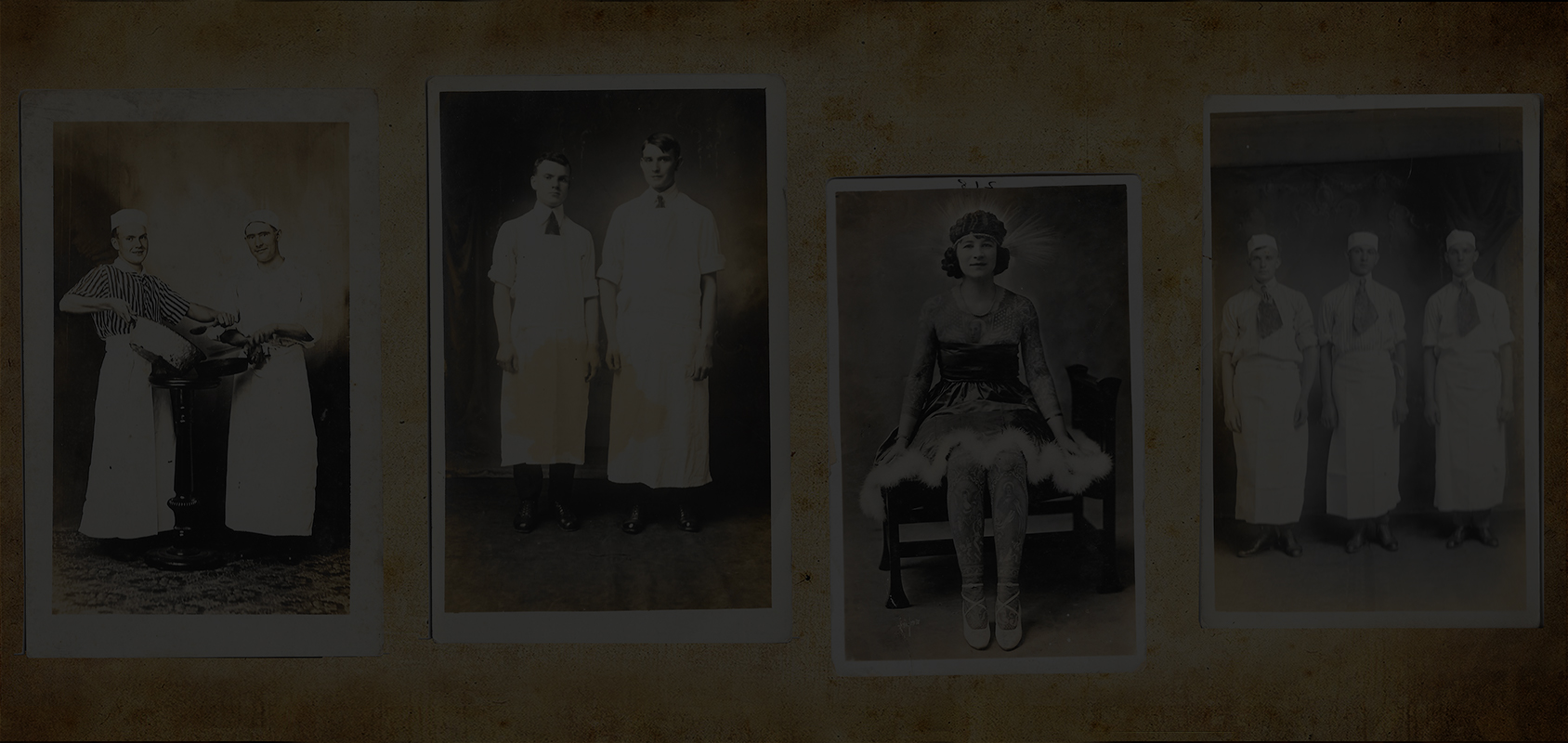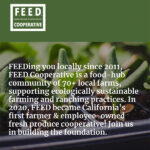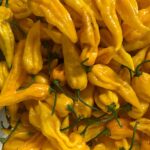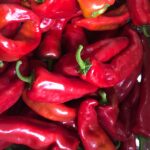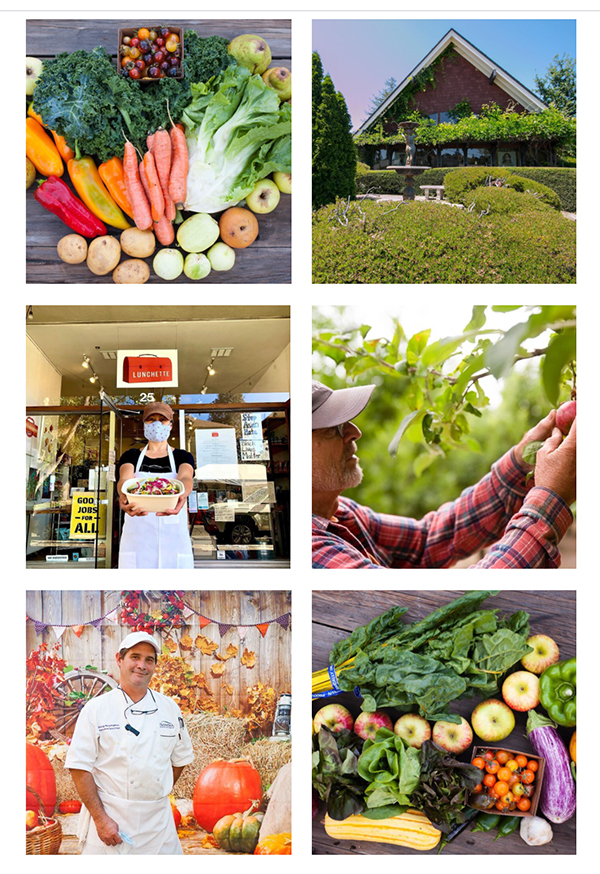
01 Oct FEED Sonoma
FEED Sonoma is, as per their website:
‘FEEDing you locally since 2011, FEED Cooperative is a food-hub community of 70+ local farms, supporting ecologically sustainable farming and ranching practices. In 2020, FEED became California’s first farmer & employee-owned fresh produce cooperative! Join us in building the foundation.’
Twice a week I get a list of the best, local, seasonal, small farm produce and artisanal food products money can buy emailed to me. I put my order in, which is conveyed to the network of farmers and makers, and two days later I get the product delivered. Now, as a chef, the first level of enjoyment I get out of such a dynamic is the product. A chef is only as good as his/her ingredients, and FEED provides me with the best possible ingredients. Every time I unpack and put away the FEED order it feels, not to venture too far into hyperbole, life affirming. It’s everything we love about what the food system could be, and every season has me looking forward to the fruits of the labors behind the product and how I can ‘play’ with said bounty. Secondly, it’s hard to be in this business and not feel the relationships between the consumer and the purveyor. This means a couple of things in restaurants. Whom we buy from: restaurant folk have different relationships with the different people whom they purchase product from. These relationships (like all) are fortified over time, informed by history, strengthened or weakened by intent or dereliction. It’s incredibly fulfilling, professionally and ideologically, to be part of such a simple and honest cycle of developing relationships with people who have a passion for growing/making/producing healthy, vibrant and intentional consumables, preparing them with care and serving them to people who trust us with their time and taste buds. Also there is the relationship between the restaurant and the guest. Restaurateur is one who runs restaurants, but comes from the latin restaurator, meaning ‘one who restores’. The platonic ideal for what we can accomplish in restaurants is being able to provide an experience that is healthy for the body, mind and soul. So how we choose to spend our resources in order to provide a desired experience is an important part of how we define who and what we want to be in this space.
Enough of the spiritual mumbo jumbo. What does this mean practically? Well it is pepper season, and farmers are always trying new varietals out which means we as chefs stay engaged and become proficient in cooking new items/dishes—and evolve professionally. For example, shishito, padron and jimmy nardello peppers have been quite popular the past ten years or so, so of course we have incorporated them into our repertoire. The past five years or so has seen an explosion In the variety of spicy peppers available in the greater Sonoma County farming community. For example, Paul’s produce in Sonoma has been growing fresh cayenne and fatalli peppers the past few years, so I am fermenting both, simply with salt, garlic and water for red and orange hot sauces, respectively. We will put these in bottles and use them in the restaurant. Does it cost more than buying tabasco and sriracha? Considerably. But it’s a live fermented, organic local product that is unbeatable in flavor (to my taste) and nutrition. And it allows us to think of things that specifically are made better by the inclusion of a fermented hot sauce, and to gild the lily of the guest experience. All star organics in Woodacre have been growing fresh Aleppo peppers. Many restaurants have been using powdered Aleppo (from Syria) for years, but now we have the ability to dry it ourselves and use it in its freshest state. Another example is the fresh paprika peppers we got from Russian River Organics in Healdsburg. Store bought paprika can taste bland and uninspired, but drying and powdering these peppers is a revelation regarding its reverence as an ingredient that can only be beaten by being cooked for by a Hungarian grandmother. So, next week I will be making paprikas with braised lamb and spaetzle. Without this marvelous ingredient, my interest in this dish, and its inclusion on the menu wouldn’t have happened. The interest by the farmer in a seed or product leads to his/her growth, which leads to the interested chefs’ growth which leads to, hopefully, a more interesting and delicious menu for the guest.
And this is just peppers. On and on it goes all year. FEED also carries some cheeses from local producers, lots of honey, whole grass fed beef, bone broth and a ton of killer pickles and fermented products. And the kicker is? It’s run by a totally rad bunch of folks.
It is important to point out that if everything was equal, this would be a more common approach, but obviously these products cost more than ‘commodity’ products, grown for the express purpose of quantity over quality. And restaurants are a business. And that business is beholden to the financial dynamic of supporting the people that run it and work there. This is why an important part of all of this is the guest/consumer. Without a public willing to participate in paying more for an objectively better product, the business can’t exist. Everyone who eats at McDonalds or In-N-Out is under no misapprehension about what they are consuming. And not everyone can afford the price tag associated with eating healthy (a point i’d counter with ‘either make time for health or make time for sickness’). Not everything we ever use is grown so close to us, or available as ‘organic’. For example, citrus is used all year round but only locally available briefly. And organic availability is spotty and can be prohibitively expensive at times. These are just the real aspects of running a business, which has a certain expectation to provide certain things. We weigh these decisions (are we able to convey to the guest why we can’t provide something without it interfering with the hospitality we want to provide?) and make decisions that are nuanced, but always carefully considered. The Bull Valley Roadhouse team decided that we want to be as positive a force as we can, while being as honest and open as possible. The intentionality behind the food, beverage, design and hospitality means we can rest comfortably (in those brief moments we allow ourselves) knowing that we are truly trying to restore our guests in the best ways we know how.


